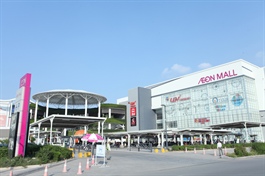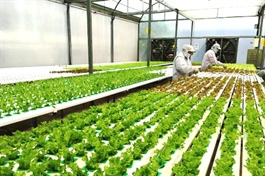Saigon River has potential for tourism development
Saigon River has potential for tourism development
Rivers flowing through cities around the world bring many benefits for the residents living there. When people from Ho Chi Minh City travel on the Chao Phraya River in Bangkok in Thailand they are reminded of many similarities they see with the Saigon River back home.
Saigon River. |
The Chao Phraya River that flows through Bangkok, provides many benefits and comforts to the people living in this Thai Capital City. The Chao Phraya River is well-known as a historical river, and it has over the years been a valuable source of revenue as it contributes greatly to the GDP of Bangkok, with more than 60% of revenue coming from tourism alone.
River of Thai Kings
The Chao Phraya River in Bangkok is also known as the Menam River, and often also called the River of Thai Kings. It is 372 km in length which includes the length of 27 kms flowing through the city of Bangkok. Along its two banks are thirty-four docks, and all of them are popular tourist attraction sites. Along the banks are also several well-known interesting sites like pagodas, museums, restaurants, hotels, theme parks, flower gardens, floating markets, and traditional markets.
Among the most beautiful spots are the Royal Palace and the Wat Phra Kaew site, better known as the Temple of the Emerald Buddha or locally called the Wat Phra Sri Rattana Satsadaram; the Royal Barge national museum; the Wat Arun Temple; the night market named Asiatique the Riverfront; and the 76-meter-tall tower designed to look like broken pieces of a shipwreck.
At night the river waters shimmer to create a magical site and a vibrant atmosphere after sunset, which tourists enjoy a lot. European travelers describe this part of Thailand as the ‘Venice of the East’. Every year, millions of tourists travel on this river and take in the exotic sites of Bangkok. It is almost impossible to meet all the needs of the visitors even though there are five professional fleets of boats run by the local people in five different colors of blue, yellow, green, orange, and brown, moving continuously along the river from 6:00 am to 7:30 pm daily. To avail of rides on these boats, tourists must make reservations well in advance. This legendary river has inspired many big cities around the world to make plans on how to take the most advantage of their rivers.
Developing Saigon River
In recent years, authorities in Ho Chi Minh City have been looking for ways to take advantage of the Saigon River and make it a major tourist attraction, which will eventually bring great benefits for the people living in and around Ho Chi Minh City. For a river to become an economically beneficial asset, it must satisfy at least two fundamental requirements. It must be a beautiful river with surrounding scenic landscapes, and it must also embrace all the cultural values of the region. The Saigon River absolutely meets both these two criteria.
Geographically, the Saigon River stretches a total length of 256 kms, with 80 kms flowing through the historical city of Ho Chi Minh City. As far as its flow and shape is concerned, the Saigon River is more beautiful than the Chao Phraya River in Bangkok. While the Chao Phraya River is straight with a swift flowing current, the Saigon River from Landmark 81 or Bitexco Tower in District 1 flows in a meandering way with several curves and turns that wrap along the banks that touch several beautiful spots of Ho Chi Minh City. The parts of the river that flow along Thanh Da, Thao Dien and Thu Thiem look very much like semicircles and sharp curves.
Towards the downstream part of the river, the waters flow slowly down into the East Sea. The Saigon River is not very wide and has lovely natural landscape along its two banks that can easily mesmerize visitors. The upper end of the river in Ho Chi Minh City is a natural forest in the suburban district of Cu Chi and the lower end is at the Can Gio Mangrove Forest, which has been recognized by UNESCO as the world's Mangrove Biosphere Reserve.
To develop the Saigon River as a heritage river, authorities in Ho Chi Minh City must first have a practical philosophy of developing the entire length of the Saigon River that flows through Ho Chi Minh City. It is then essential to make plans for developing key spaces, and introduce appropriate policies on environmental, cultural, and socio-economic improvement plans. It would be best to make the project known to the world and organize an international competition to collect the best ideas and designs before raising the biggest possible fund for actualization of this massive project. The participants of the competition must be required to fulfil three major tasks.
First, it is vital to establish a soft, green ecological urban strip along the Saigon River. It must be scientifically and elaborately planned. This will form the backdrop to architectural space that will facilitate the nurturing of our past cultural heritage. However, it should be noted that the four following things must not be done, namely, concreting the riverbanks, sub-dividing land plots for housing development, building roads for transport, and constructing rows of high-rise apartment buildings that will deny the residents’ easy access to the Saigon River.
Second, it is imperative to gather and assess significant information about our heritage and classify this information to make it possible to take the most advantage of the various sites. For instance, it is important to determine how far some sites are from the riverbanks and how roads and streets and lanes can be improved for easy accessibility. Competent agencies must also decide where it is necessary to build additional works such as small docks, waiting sheds, restaurants, and restrooms.
Finally, it is fitting that tourist attractions should all be renovated. Since lots of areas along the 80 km stretch of the Saigon River is still unused, it is now an appropriate time to construct such works as theme parks, museums, restaurants, hotels, statue gardens, food gardens, and ecological farming areas for visitors to experience farming activities in the Vietnamese style.
It is very much possible to market the Saigon River that flows through Ho Chi Minh City as a historical and cultural river. Promoting the river can highlight its heritage value, and consequently reap its many benefits that would add substantial revenue to Ho Chi Minh City. There is no doubt that the Saigon River can bring substantial economic benefits to Ho Chi Minh City and its residents, by making the best use of its flowing waters, its riverbanks and land funds.
Like the Chao Phraya River in Bangkok, the Huangpu River in Shanghai in China, the Han River in Seoul in South Korea, and the Moscow River in Russia, that contribute billions of dollars to the tourism industry every year in their respective countries. By 2040, it is hoped that many historic changes will be made on and along the Saigon River that will highlight and benefit the beautiful ancient city of Saigon.






















